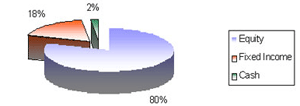- Mr. Ramkumar H. Barchha
- +91.281.2462424
- info@vikalpafinvest.com
Useful Links
Download Center
- Vikalpa MF Report Card
- Vikalpa SIP Report
- Power of equity
- Vikalpa Ulip Multimeter
- Vikalpa Funds Watch
- Mutual Fund Category-wise Classification
- New names of MF Schemes of various AMC as per SEBI's broader classification
- Budget Highlights 2025
- Grievance Redressal Policy
- Risk Assessment Questionnaire
- Client profile
- Vikalpa Fund Barometer
There are three major asset classes that you can put your money into, namely equities, fixed income and money market instruments. In order to decide how much of your money goes into which investment class you must first consider a few important factors (most of these will be tackled by you during your goal definition phase):
• Return expected on your investment
• Amount you will be able to save (present as well as future)
• Cash outflows you might have at certain points of time in the future
• Risk appetite
• Amount you will require for your retirement
• Liquidity
• Your Age
Hence due to the variable nature of the investor’s finances and requirements there are no set strategies used by financial consultants. But we can provide you with broad strategies that you can adapt to meet you own needs.
But first please take a look at the chart below to see which category you broadly fall into. Investment protection leads to safer interest generating asset allocations where as Investment Growth leads to higher volatility assets, that may tend to grow over a period of time.
|
Investment Protection Vs. Investment Growth |
||
|
Investor Characteristic |
Investment Growth |
Investment Protection |
|
Time Horizon |
Short-term |
Long-term |
|
Future Income Requirements |
Steady / High |
Variable / Low |
|
Volatility Limit |
Low |
High |
|
Inflation Protection |
Low Protection Needed |
High Protection Needed |
|
Investor take on Equity Market |
Mostly Bearish |
Mostly Bullish |
If you are a person who broadly falls into the Investment Growth category you might be interested in looking at an Aggressive portfolio. On the other hand if you are leaning towards an interest income with minimal risk investments you might look at a Conservative asset allocation. Someone who wants a bit of steady income as well as asset growth might go in for a moderate or a balanced asset allocation.
| Aggressive Portfolio |
|
|
| Moderate Portfolio |
|
|
| Conservative Portfolio |
|
|
Another way to ascertain the right asset allocation is by looking at your life cycle. The basis of this theory lies in the simple maxim that younger people with secure jobs will normally opt for higher returns and take higher risks compared to older retired people. One must remember that these are only indicative strategies and will probably have to be fine-tuned to meet your individual needs.
|
Age |
Main Objectives |
Portfolio Strategy |
|
20-29 |
Aggressive Growth – Sow the seeds, plan for housing and create a safety cushion |
50% - Growth Funds |
|
30-39 |
Growth – Save for housing, children’s expenses (present and future – education etc.) and safety cushion |
45% - Growth Funds |
|
40-49 |
Growth – Children’s expenses (present and future – education etc.) and safety cushion |
40% - Growth Funds |
|
50-59 |
Retirement – Save for retirement and build on safety cushion |
30% - Growth Funds |
|
60-69 |
Safety – Preserve investments/ savings and opt for minimal growth |
10% - Balanced Funds |
|
70- |
Safety – Preserve investments/ savings |
30% - Income Funds |




